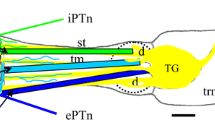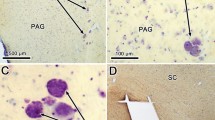Abstract
The tentacle withdrawal reflex of snails is perhaps the fastest, most sensitive reflex in the animals' repertoire. We have investigated the sensory inputs to a major motoneuron (C3) mediating the reflex. The cell C3 is sensitive to both chemical and mechanical stimulation, but there is little or no discrimination of quality in chemical stimuli. Small increments in the concentration of chemical stimuli produce large changes in neuronal responses. When chemicals are applied to the afferent nerve, the effects are comparable to those caused by applications to the olfactory epithelium, suggesting that the transducing elements are unspecialized. The afferent pathway is independent of the procerebrum, which is the primary olfactory lobe. Two excitatory synaptic inputs are identified, both of which originate in the tentacle, propagate centrally and synapse directly onto C3. A small, low threshold input is assigned to dendritic sites distant from the soma. A larger, higher threshold input is assigned to proximal dendritic sites. The latter input is largely responsible for the strong activation of C3 following noxious stimulation of the tentacle. The sensory inputs to C3 have properties similar to those of fibres in the nasal branch of the vertebrate trigeminal nerve.
Similar content being viewed by others
References
Balaban PM (1993) Behavioural neurobiology of learning in terrestrial snails. Prog Neurobiol 41: 1–13
Bewick GS, Price DA, Cottrell GA (1990) The fast response mediated by the C3 motoneurone of Helix is not attributable to the contained FMRFamide. J Exp Biol 148: 201–219
Chase R (1985) Responses to odors mapped in snail tentacle and brain by 14C-2-deoxyglucose autoradiography. J Neurosci 5: 2930–2939
Chase R, Kamil R (1983) Neuronal elements in snail tentacles as revealed by HRP backfilling. J Neurobiol 14: 29–42
Chase R, Tolloczko B (1993) Tracing neural pathways in snail olfaction: from the tip of the tentacle to the brain and beyond. Microsc Res Tech 24: 214–230
Christoffersen GRJ, Frederiksen K, Johansen J, Kristensen BI, Simonsen L (1981) Behavioural modification of the optic tentacle of Helix pomatia; effect of puromycin, activity of S-100. Comp Biochem Physiol 68A: 611–624
Cottrell GA, Schot LPC, Dockray GJ (1983) Identification and probable role of a single neurone containing the neuropeptide Helix FMRFamide. Nature 304: 638–640
Cottrell GA, Price DA, Doble KE, Hettle S, Sommerville J, Macdonald M (1992) Identified Helix neurons: mutually exclusive expression of the tetrapeptide and heptapeptide members of the FMRFamide family. Biol Bull 183: 113–122
Fredman SM, Jahan-Parwar B (1977) Identifiable cerebral neurons mediating an anterior tentacular withdrawal reflex in Aplysia. J Neurophysiol 40: 608–615
Gelperin A, Tank DW (1990) Odour-modulated collective network oscillations of olfactory interneurons in a terrestrial mollusc. Nature 345: 437–440
Getchell TV, Shepherd GM (1978) Responses of olfactory receptor cells to step pulses of odour at different concentrations in the salamander. J Physiol (London) 282: 521–540
Getting PA (1976) Afferent neurons mediating escape swimming of the marine mollusc, Tritonia. J Comp Physiol A 110: 271–286
Gillette R, Saeki M, Huang R-C (1991) Defense mechanisms in notaspid snails: acid humor and evasiveness. J Exp Biol 156: 335–347
Kandel ER, Tauc L (1966) Anomalous rectification in the metacerebral giant cells and its consequences for synaptic transmission. J Physiol (London) 183: 287–304
Keele CA (1962) The common chemical sense and its receptors. Arch Int Pharmacodyn Ther 139: 547–557
Parker GH (1912) The relations of smell, taste and the common chemical sense in vertebrates. J Acad Nat Sci Phila 15: 221–234
Peppel P, Anton F (1993) Responses of rat medullary dorsal horn neurons following intranasal noxious chemical stimulation: effects of stimulus intensity, duration, and interstimulus interval. J Neurophysiol 70: 2260–2275
Prescott S, Chase R (1996) Two types of plasticity in the tentacle withdrawal reflex of Helix aspersa are dissociated by tissue location and response measure. J Comp Physiol A 179: 407–414
Rall W (1967) Distinguishing theoretical synaptic potentials computed for different soma-dendritic distributions of synaptic input. J Neurophysiol 30: 1072–1193
Rosen SC, Weiss KR, Kupfermann I (1979) Response properties and synaptic connections of mechanoafferent neurons in cerebral ganglion of Aplysia. J Neurophysiol 42: 954–974
Silver WL (1992) Neural and pharmacological basis for nasal irritation. Ann NY Acad Sci 641: 152–163
Tauc L (1962) Site of origin and propagation of spike in the giant neuron of Aplysia. J Gen Physiol 45: 1077–1097
Teyke T, Weiss KR, Kupfermann I (1989) A subpopulation of cerebral B cluster neurones of Aplysia californica is involved in defensive head withdrawal but not appetitive head movements. J Exp Biol 147: 1–20
Walters ET, Erickson MT (1986) Directional control and the functional organization of defensive reflexes in Aplysia. J Comp Physiol A 159: 339–351
Xin Y, Kupfermann I (1995) Neuronal pathways mediating head turning behavior in Aplysia. Neurosci Lett 186: 197–199
Zaitseva OV (1992) Structural organization of the sensory systems of the snail (in Russian). Zh Vyssh Nervn Deyat im I.P. Pavlova 42: 1132–1149. Translation in Neurosci Behav Physiol 24: 47–57 (1994)
Zakharov IS, Matz VN, Balaban PM (1982) Role of the giant cerebral neuron in control of defensive behavior of Helix lucorum (in Russian). Neirofiziologiya 14: 353–358. Translation in Neurophysiol 14: 262–266 (1982)
Author information
Authors and Affiliations
Rights and permissions
About this article
Cite this article
Chase, R., Hall, B. Nociceptive inputs to C3, a motoneuron of the tentacle withdrawal reflex in Helix aspersa . J Comp Physiol A 179, 809–818 (1996). https://doi.org/10.1007/BF00207359
Accepted:
Issue Date:
DOI: https://doi.org/10.1007/BF00207359




